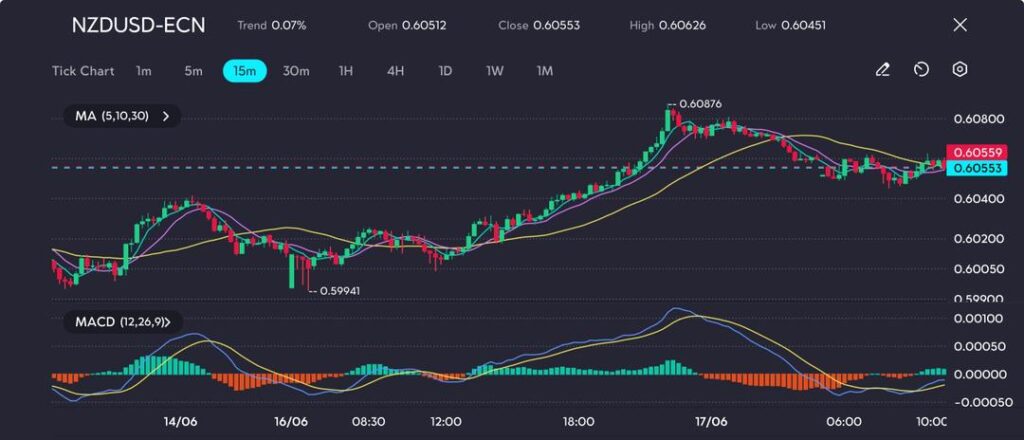
Key Points
- NZD/USD pulls back to 0.60553 after peaking at 0.60876
- NZ food inflation jumps to 4.4%, stalling expectations for aggressive RBNZ cuts
The New Zealand dollar gave up ground on Tuesday, slipping to $0.60553 after touching an intraday high of $0.60876. The risk-sensitive currency weakened as traders pulled back from risk-on trades amid escalating hostilities between Israel and Iran, now entering a fourth day. Reports suggest Tehran has appealed to global powers to restrain the U.S. and de-escalate tensions, while Israel continues its strikes with no indication of compromise.
Markets responded swiftly by rotating into safe-haven assets, with the kiwi dollar taking a hit alongside other growth-linked currencies.
Domestically, the latest economic print surprised markets. Food prices in New Zealand surged by 4.4% year-on-year in May, up from 3.7% in April—marking the highest pace of increase since December 2023. This uptick in cost pressures could complicate the Reserve Bank of New Zealand’s (RBNZ) path forward, especially as markets had begun to firmly price in an end to the current rate-cutting cycle.
At present, traders see only one more rate cut on the table, with 25 basis points expected by November. With inflation showing signs of persistence, further easing may become more conditional on weaker growth data.
Technical Analysis
The NZD/USD 15-minute chart shows a modest recovery from the 0.5994 low on 14 June, supported by a consistent uptrend into the 0.6087 high on 17 June. This upside move was backed by a rising MACD histogram and positive crossover, with the price holding above the 30-period MA until early today. However, momentum has since cooled, and the pair pulled back toward the 0.6045–0.6050 support zone, where price is now consolidating.

Picture: 0.6087 rejected, 0.6050 becomes key battleground, as seen on the VT Markets app
The MACD is beginning to flatten after a brief bearish crossover, suggesting indecision rather than a full reversal. Moving averages are tightening, which could foreshadow a breakout, especially as the 0.6050 level becomes a pivot zone. Traders should watch whether bulls defend this line or if bears force a breakdown toward 0.6030.
Fundamentally, the New Zealand dollar has been supported in recent sessions by risk appetite returning to markets and stabilisation in dairy auction results. However, traders remain cautious ahead of Wednesday’s RBNZ rate decision, where the central bank is widely expected to hold rates at 5.50%. Market participants will scrutinise the tone of the statement for any tilt toward easing later in the year—especially after recent softness in NZ manufacturing and house price data.
Looking ahead, market participants are waiting for a busy local data slate this week, including current account figures, the Westpac Consumer Confidence Index, and Q1 GDP. Any signs of underlying resilience or deterioration in New Zealand’s economic activity could reshape rate expectations and drive volatility in the NZD.









